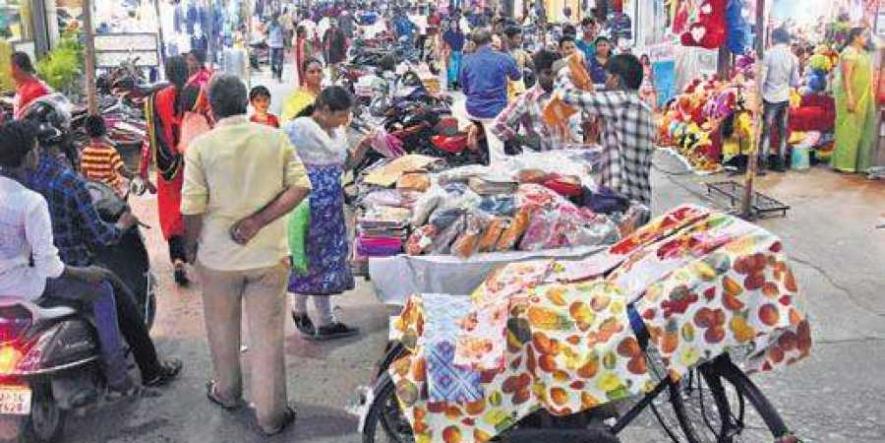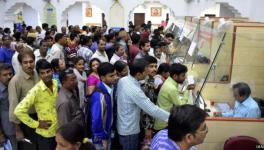‘Streets will Show the Way’: How Vendors are Looking to Tide Over Economic Distress

Image Courtesy: The New Indian Express
Kolkata, September 9: Raju, a vendor who runs a tea stall at the New Jalpaiguri Junction railway station, attempted self immolation on August 31. He is not the only vendor in India who tried to, or ended his life. A mismanaged economic disaster continues to worsen under the Bharatiya Janata Party-led Narendra Modi government, which stubbornly rejects the sane counsel that India urgently needs a demand stimulus, has driven people like Raju to the edge.
Street vendors, like daily wage workers, were savagely impacted by the sudden and harsh lockdown put in place due to COVID-19. The estimated four crore persons engaged in the business of selling on the streets, in the metros, in small towns and in rural hubs across India, personify the under exploited, ineffectively harnessed entrepreneurial spirit of India. An estimated 70 lakh to 80 lakh vendors, who sold everything – ranging from unbranded lozenges to cheap Chinese gizmos – on the 20,000 long distance and suburban trains across India have evaporated, since the trains are no longer plying.
A “low circuit” and parallel economy with a turnover of about Rs 8000 crore a day, every street entrepreneur or trader supported an average of three others – as employees, partners, workers or through commission. All of them earned a livelihood which was bare, but sufficient. The entrepreneur on the street may have been the proprietor, a lessee, an employee or working for a commission; he and she were all autonomous persons.
The irony is that vendors, the largest segment of the self-employed in the country, are regarded as a problem and are an easily ignored part of the informal sector by governments, policy experts and the affluent. The pandemic, however, pushed the government to make a tiny accommodation for these vendors, offering the registered or certified vendors a miniscule loan of Rs 10,000 to restart their businesses.
The government seemingly did not consider that without demand being stimulated, without cash compensations to people who were forced out of work as a consequence of the long and hardlock down and sent a weak economy into a tailspin, street vendors and hawkers would have no customers. Restarting businesses without buyers was not an option for men and women who were already on the margins.
In April, Shaktiman Ghosh, general secretary and founding member of the National Hawkers Federation (NHF), had not expected that the economy would not restart and revive. He was certain that hawkers would be able to go back on the streets with the goods that they had carefully stored away, and that they would recoup their losses because of their indomitable enterprising spirit.
In September, Ghosh has embarked on a country-wide mission to salvage the future from the ruins of the present. On the road from Indore to Vadodara, Ghosh unveiled a strategy that would formalise their businesses, transform the “problem” of their encroachment of urban spaces and integrate vendors as bankable entrepreneurs worth approximately Rs 4,000 crores in loans without too many defaulters.
The NHF has now faced facts; the massive economic contraction has devastated most of their four crore members who have sold almost everything they possessed to survive. Restarting their businesses will require the infusion of tiny packets of capital from which the vendors can restock and rebuild their lives.
In the expectation that street vendors will return to their places of business, sooner, rather than later, the NHF is crafting a strategy that leverages the loan offered as part of the Modi government’s stimulus policy, to solve the four worst problems that drain the wealth created by vending.
The four problems are credit availability, as vendors typically borrow from money lenders to start up, stock and tide over bad times; municipalities, that are indifferent and reluctant to issue certificates legitimising the trade, typically restricting the registered vendors to about 25% to 30% of the total number of people; police, who can use the absence of certificates to harass and extort; and, middle class buyers, who typically see vendors as an opportunity to drive a cheap bargain, undeserving of respect, because their work is not dignified as a formal business.
After months of fund-raising to run community kitchens and food banks for destitute hawkers, the NHF has developed a strategy that leverages the paltry Rs 10,000 loan offered by the Modi government through banks to legitimise vendors, cut out money-lenders and compel municipalities and municipal corporations to issue pending permanent certificates to vendors who were recognised during the survey and issue temporary certificates to those left out of the survey.
Recognising that street vendors were entrepreneurs and that they too should have rights, the Street Vendors (Protection of Livelihood and Regulation of Street Vending) Act of 2014 was brought in to turn a precarious existence into an established model of doing business. The role of hawkers-street vendors in every urban area as a model for creating livelihoods was made permanent.
Two and a half per cent of the land in every city was set aside for street vendors under the Act. Their existence and contribution was recognised and the Act provided for regulation through Town Vending Committees. The Act required areas to be surveyed, hawkers to be registered and licensed to trade. Ghosh hopes that the gap between their members and the government’s estimates of the number of vendors, will be bridged by a committee comprising hawkers unions, the municipalities-municipal corporations, urban development departments and the police.
From Gujarat, Madhya Pradesh, Delhi and then on to Telengana and Andhra Pradesh, Ghosh is meeting with unions affiliated to the Federation, explaining the advantages of the revival strategy and offering hand-holding by the unions that vendors will need to connect with banks. It is so that the loan, which is the lynchpin of their strategy, can get them going. The expectation is that because banks will give loans to vendors who apply for it, the issue of certificates will be expedited, regardless of whether the certificate is an ad hoc paper or a permanent one.
The NHF has engaged with banks to create a solution to the inevitable problem of defaults on loan repayment. Instead of repaying the loan after six months or 12 months, the Federation has recommended to the banks that they should recruit and train an army of collection agents, who will be paid a one percent commission to do door-to-door collection every week. “Hawkers find it difficult to pay out a large lump sum. They can more easily pay the approximately Rs 241 a week that will be required to service a Rs 10,000 bank loan,” Ghosh explained.
Hawkers who repay the first loan will be entitled to double the amount as a loan from the bank, Ghosh said. This would help to transform the vending trade and allow it to grow fast enough and in ways that could challenge online businesses, like Big Basket and even Amazon, he added. Over the past two years – before the pandemic hit – hawkers had taken a hit from online businesses.
With more capital, better organisation and new models of competitiveness, the NHF believes hawkers would be able to effectively beat off the threat from online businesses. Almost entirely financed by money lenders, vending creates wealth that is then transferred out of the business. For a Rs 1,000 loan taken in the morning to buy stock, the vendor has to repay Rs 1,100 at the end of the day. In certain cases the interest can add up to 300% per cent, which impoverishes the vendor, regardless of how hard he or she has worked.
Driving across the heartland of India, Ghosh explained, “We have launched a pilot in Kolkata, hawkersbazar.com. We are negotiating with farmers to buy directly and sell to customers. We are working with vendors to up-skill them to produce and package cooked food products that will satisfy standards demanded by middle-class customers.”
The need to transform the sector is urgent. Food comprises 50% of vending businesses; fruits and vegetables comprise about 35% and are the best source of goods in remote and far flung rural areas. About 20% of vendors sell garments, toys, household goods and other products including electricals, electronics and accessories for computers and mobiles.
Each of these segments have suffered a massive blow – street food stalls have almost disappeared. Even as the lockdown has been relaxed and offices have reopened, consumers of street food have largely not risked venturing out. The loss of jobs, the savage pay cuts, the drastic shrinking of daily commuters and migrant workers has meant that the usual buyers have evaporated; those who can afford to buy are not doing so, holding on to their cash in apprehension of harder times to come.
The spurt in numbers of fruit and vegetable sellers, fish mongers, people who hawk bread, eggs and milk in residential areas during the lock down may have been a life line for consumers holed up in isolation in their homes, with the shops and markets shut. The increase in the numbers of vendors points to a large-scale distress among daily wage workers – people who lost their livelihoods because the work they did has dried up. Not competition, but distress has driven people to fall back on vending as an alternative to the paid work they did before the pandemic.
The mantra driving the strategy to reshape the future of vending – as and when demand, that has reached rock bottom, picks up – is “the streets will show the way,” a rough translation of Left poet Subhash Mukhopadhyay’s rastai ekmatra rasta.
The writer is a freelance journalist. The views are personal.
Get the latest reports & analysis with people's perspective on Protests, movements & deep analytical videos, discussions of the current affairs in your Telegram app. Subscribe to NewsClick's Telegram channel & get Real-Time updates on stories, as they get published on our website.
























